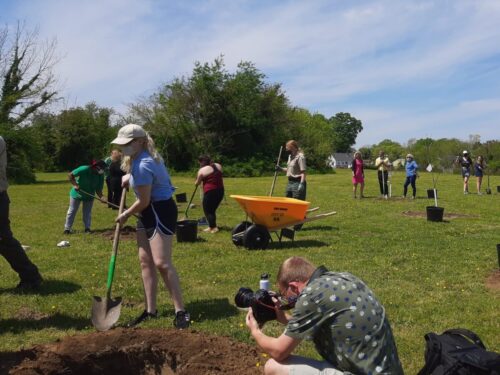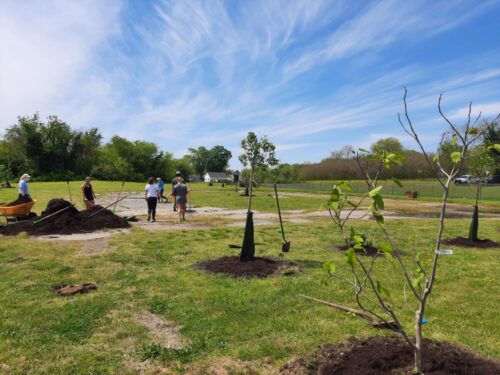Growing a Food Forest
May 18, 2021 4:21 pm

By Meghan Mulroy-Goldman, VDOF Community Forester
Ever wonder where the fruit in the grocery store comes from? In today’s supermarkets, you can find fruit and nuts from across the country and globe. You might find bananas from Guatemala, almonds from California, and apples from New York. Many familiar foods grow on trees and can be grown right in your backyard, in city parks, or even on street trees! While growing fruit at home was once a common practice out of necessity, it fell out of favor with the convenience of supermarkets. Today, however, many people are working to bring fruit and nut trees back into our cities and towns, in what can be called a “food forest.”
These food forests can be a great resource to communities, particularly those in food “deserts” where residents might not have easy access to fresh fruits. They can provide all of the usual benefits of trees – shade, reduction in the urban heat island effect, clean air, and clean water, to name a few—with the added benefit of providing a healthy and tasty snack. Imagine going for a walk, and plucking a nice fresh apple off a neighborhood tree to satisfy your hunger.
What might you find in one of these food forests? While we can’t grow everything you would find in a grocery store (sadly, banana trees and pineapples just won’t make it here in Virginia), you can find things like apples, pears, plums, apricots, and even pomegranates in the warmer parts of the state. You can also find nut trees like pecans. In addition to these familiar fruits, there are also lots of fruits that you might not find in a grocery store, like pawpaw, persimmon, red mulberry, and serviceberry. While all four of these are native Virginia trees, you aren’t likely to find their fruit in the grocery store. Planting them in food forests is a great way to share these tasty, but unfamiliar, fruits with communities.
In early May, the Newport News Green Foundation and the Virginia Department of Forestry (VDOF) began to make a food forest a reality. Tami Farinholt, the director of the Green Foundation, had dreamed of bringing a food forest to Newport News, and when the five-acre parcel in the Southeast community of Newport News was donated to the Green Foundation, she knew this would be a perfect location. The Green Foundation hopes that the food forest can both help address food scarcity in the area and promote the environmental benefits of green spaces.

Many volunteers make short work of planting.
I had the pleasure of working with the Green Foundation to develop a planting plan for phase 1 of their food forest installation, which includes figs, serviceberries, Asian pears, persimmons, and plums. Last week, thirty-five fruit trees and shrubs were installed by volunteers from the Newport News Green Foundation and VDOF staff. A local newspaper covered the story. Future plans for the site include an outdoor classroom for the nearby elementary school, community garden beds, an herb garden, and more fruit trees. Everyone is excited about the new source of fruit at the Peninsula’s first food forest and looks forward to seeing that food really does grow on trees!

Freshly planted fruit trees
Tags: Fruit, Partnerships, Tree Planting, Urban Forestry
Category: Urban and Community Forestry
